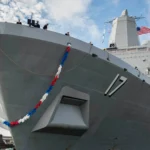France thinks of itself as a power in the Indo-Pacific, a fact often ignored by Germany. But can Paris achieve its goals in this vast geopolitical area?
During his state visit to China in April, French President Emmanuel Macron made controversial statements about the European Union and Taiwan, provoking outrage both in Europe and the United States. The statements, made after Macron met with President Xi Jinping, also drew considerable criticism in Germany, where commentators suggested the remarks were a rehearsal for possible rapprochement with Beijing, something that could threaten to divide Europe.
The wave of criticism was understandable, against the backdrop of Chinese military maneuvers around Taiwan, as well as the ongoing Russian war against Ukraine. But many of the accusations made against the French president from Germany were ill-informed cheap shots. This can be seen by a clear-eyed look at the geographic, economic, and political realities in the Indo-Pacific, including a comparative assessment of German and French engagement in the region. Above all, the criticisms made of Macron revealed the ignorance of many observers, who seemed unaware the fact that Macron was visiting China as an Indo-Pacific head of state, as well as a European one.
The attention of Germany and most EU countries is almost exclusively focused on Russia’s aggressive war on Ukraine; Indo-Pacific conflicts are at the furthest edge of Europe’s field of vision. There are considerable arguments over the meaning of the “Indo-Pacific” itself, a fact which itself bears out the widespread tensions in the region.
“Indo-Pacific” is primarily a geographical term. By most definitions, it includes a vast expanse from the east coast of Africa to the US west coast, with the Suez and Panama canals as its main entrances and the straits of Singapore and Malacca at its center, forming two key arteries of international maritime trade. But this is no simple geographical term; its use involves considerable geopolitical calculation. Since the turn of the millennium, an increasing number of countries have used “Indo-Pacific” in place of other possible terms, including “Asia-Pacific.”
The concept of “Indo-Pacific” emerged as a response to China’s growing influence. Japan introduced the term in the early 2000s, followed by other states, including India in 2010 and Australia in 2013. The French government altered its vocabulary slightly later: Key French documents from as recently as 2013 still use “Asia-Pacific,” for example the White Paper on Security and Defense Policy.
Linking together the Indian and Pacific Oceans creates a new geopolitical space, one where Chinese hegemonic efforts in South and Southeast Asia are confronted by India, as a second power in the region. For this reason, the Chinese leadership refuses to use the term and criticizes its adoption as a form of geopolitical manipulation on the part of Washington. Member states of the Association of Southeast Asian Nations (ASEAN), including Malaysia, Thailand, and Singapore, have also been critical of the new designation, fearing that the concept’s emphatic logic of US-Chinese great power conflict could diminish their importance in the region.
Indo-Pacific France
France is directly affected by the growing tensions in the region. For both Berlin and Paris, it is crucial to protect free trade routes as well as the much-discussed international rules-based order. But for France, it is also—and above all—a question of national territory. Macron regularly emphasizes that France is an “Indo-Pacific country,” as do policy guidelines issued by the French foreign and defense ministries.
Of the 13 French overseas territories, three are located in the Indian Ocean (Réunion, Mayotte, and the Southern and Antarctic Territories) and four in the Pacific (New Caledonia, French Polynesia, Wallis and Futuna Islands, and Clipperton Island). Between them, these seven territories amount to about 90 percent of France’s Exclusive Economic Zone (EEZ), covering 10.2 million square kilometers, the second largest in the world after the United States. Within the Indo-Pacific region, 1.6 million French citizens live on French national territory, as well as 400,000 more who are resident in other countries in the region.
There are already major geo-economic interests associated with these French overseas territories, which look set to become even more important in the future. On its own, the uninhabited Clipperton Island – located in the North Pacific, far off the Mexican coast – provides an EEZ the same size as that of Sweden. This zone is now the site of intensive fishing activity, and could also see the future development of resources on the seabed. A January 2023 report by the French Senate underlines the importance of having access to these resources. It gives the example of New Caledonia, in the South Pacific to the east of Australia, which is believed to hold around 20 percent of the world’s deposits of nickel, a raw material needed for the production of batteries for electric vehicles, among other things.
France guards its interests in the Indo-Pacific through a dense diplomatic network. Paris has 25 embassies in the region, 14 consulates-general, and two non-diplomatic missions, in North Korea and Taiwan. In 2020, Christophe Penot was appointed as the first ambassador to the Indo-Pacific region as a whole, with the intention of coordinating France’s various diplomatic activities. French cultural diplomacy is alive and well in the region, with 35 French cultural institutes (Alliances Françaises), and almost 100 educational institutions, which offer teaching through French. Regional cooperation on security and defense policy is another key concern for France: In 2022, the country had a total of 18 accredited defense attachés in the Indo-Pacific region.
France’s diplomatic presence is complemented by a military presence, which is capable of defending French citizens and national territory in the event of emergency. Its military in the region, referred to as “sovereignty forces,” are organized into five regional commands, based on French sovereign territory in the southern Indian Ocean, New Caledonia, and French Polynesia, as well as at bases in the United Arab Emirates and Djibouti, thanks to bilateral agreements. The forces deployed vary in strength from 7,000 to 8,000, depending on whether exercises are being held, as they regularly are.
French liaison officers have also been sent to many partner countries, including Singapore, South Korea, and the US 7th Fleet, based in Japan. The first French Indo-Pacific strategy during the Macron presidencies was from the defense ministry, issued before the foreign ministry published its own. In 2019, Defense Minister Florence Parly put forward an Indo-Pacific strategy at the Shangri-La Dialogue, an important regional defense summit held annually in Singapore. As the minister presented the strategy at the conference, the French aircraft carrier Charles de Gaulle lay anchored offshore.
Clear Signals
France’s armed forces regularly demonstrate operational readiness by conducting exercises in the Indo-Pacific. In 2021, the French air force sent combat, transport, and tanker aircraft from the European “metropolis” to the South Pacific for the first time, displaying the French capacity for worldwide force projection, including nuclear forces. The French navy also conducts regular missions in the region, most recently this year as part of its annual “Joan of Arc” long-duration training deployment.
So far, the German government has shied away from sending German naval ships through the Taiwan Strait because of concerns about possible Chinese reactions. For this reason, the German frigate Bayern did not take this route on its visit to the region in 2021. But the French government has used its naval diplomacy to send clear signals to Beijing. A French spy ship passed through the strait in the same year as the Bayern’s visit; for the first time, Paris also sent a nuclear-powered hunter submarine to the South China Sea on a “strategic mission.”
France’s position on China has so far been much more robust than Germany’s, contrary to claims made by many German reactions to Macron’s Taiwan comments. Early this year, Macron used his New Year’s greeting to the French armed forces to announce a new Indo-Pacific strategy, including increased military presence in overseas territories. In recent years, building on its military presence, French diplomacy has attempted to forge strategic partnerships outside the two poles of China and the United States. Following in the tradition of Charles de Gaulle, the founding father of the Fifth Republic, France hopes in this way to function as a “balancing power” between the two superpowers.
In addition to protecting its own territory and citizens, France defines itself as a “stabilizing” regional power within the Indo-Pacific region. The position can be traced through a series of keynote speeches delivered during Macron’s first term, in India, Australia, and New Caledonia. Macron’s idea of a third way—a French (or European) way—which caused considerable stir in relation to Taiwan, can already be seen in these speeches. The idea is not a new one, in fact it is based on the French cross-party consensus that France makes foreign and security policy decisions independently, without external influence, even from close allies in the EU or NATO. Hence Macron’s warning that Western strategies should not be explicitly directed against China and his search for allies to strengthen his Indo-Pacific balancing position.
In this way, the French president put clear distance between himself and American and British approaches. Strategic thinking in Washington and London increasingly aims at excluding and isolating China from regional cooperation efforts. For some time now, US policy papers have described China as an adversary. This contrasts with equivalent French policy documents, but also with the positions put forward by Germany, the Netherlands, and the European Commission, all of which have tended to refer to China with the threefold description “partner, competitor, rival.”
Whether this strategy is appropriate has been a subject of heated debate within France itself. Some observers have criticized ideas like the “third way” and definitions of France as a “stabilizing” power as unrealistic. These critical voices have become louder since the AUKUS affair of August 2021, which raised very serious doubts about France’s then Indo-Pacific strategy.
Australia and the AUKUS Shock
On September 15, 2021, after 18 months of secret negotiations, the United States, Britain, and Australia publicly announced AUKUS, their new military alliance. As part of the announcement, the Australian government said it would be pulling out of an agreed arms deal with France, confirming it would buy American submarines rather than French ones. The decision voided what had been described as the “deal of the century,” an agreement signed by Canberra with the French armaments company Naval Group in 2016. The contract had been worth some €34 billion and would have involved around 4,000 jobs. In the wake of the AUKUS announcement, the French foreign and defense ministries accused the United States of having excluded a European ally from a crucial partnership in the region. The following day, Paris went so far as to recall its ambassador from Washington at short notice, a historically unprecedented diplomatic event.
As with Macron’s Taiwan comments, the reactions of many German commentators to the AUKUS deal revealed how ill-informed they were about the Indo-Pacific role of Germany’s closest European closest ally. In Berlin, there were comments that although Paris had lost an arms deal worth billions, its outraged reaction was overdone, and so was the recall of its Washington ambassador. There was little discussion of the fact that AUKUS and the Australian decision to scrap the submarine deal had smashed a key pillar of France’s Indo-Pacific strategy, casting its entire strategic approach into doubt. In 2018, Macron had laid down the basic lines of the strategy while he was in Australia. Now the government in Canberra was indicating that it did not regard France as a relevant actor in the region and that, given the Chinese threat, it was ready to submit to American strategic thinking in the region.
India is the remaining second “pillar” of French strategy. As with Australia, French rapprochement with India was based on extensive arms deals. In recent years, the Indian government has agreed to purchase French submarines worth around €4 billion as well as 36 combat aircraft, worth some €8 billion.
The two countries have established close ties through bilateral meetings and multilateral formats like the Raisina Dialogue, an annual geopolitical conference held in New Delhi. The Indian Prime Minister Narendra Modi was the guest of honor at this year’s Bastille Day celebrations on July 14, a diplomatic gesture that underlined the importance of the relationship for France, especially in the wake of the AUKUS shock.
But India is also looking for dependable security guarantees. New Delhi is involved with the United States, Australia, and Japan in the “Quad” (the Quadrilateral Security Dialogue), an informal group for security policy cooperation, which advocates a “free and open Indo-Pacific.” For its part, China refers to the Quad as an “Asian NATO,” which serves US hegemonic ambitions. Nonetheless, India’s policy is seen as an example by many other countries in the region: While they may officially reject the zero-sum game of major US-Chinese conflict, they are unofficially boosting contacts with the United States in the face of Beijing’s growing influence.
Big Ambitions
Given these developments, Paris’ Indo-Pacific strategy is coming under increasing pressure. The AUKUS affair and closer relations between some of France’s Indo-Pacific partners and the United States have prompted an urgent question: How is France, as a “balancing” and “stabilizing” power, to maintain relevance as a foreign and security policy partner in the region? Macron recently spoke out against a NATO presence in Tokyo, blocking the establishment of the alliance’s first liaison office in the Indo-Pacific. It is no coincidence that France’s presence in the region has been the focus of the country’s multi-year defense financial planning currently under discussion, as well as of its most recent national security strategy, issued in November 2022. France is reacting to China’s growing threat to its own national territory, while also trying to offer an attractive alternative to US security guarantees in the region.
Whether Paris can achieve these goals will determine France’s idea of itself in foreign policy terms, and not solely in the Indo-Pacific. French reliance on US security guarantees to ensure the security of its territory and citizens would mark a fundamental change in its foreign policy, and a break with long-standing Gaullist tradition.
Emmanuel Macron seems convinced that France, as a European middle power, can continue to play a decisive role in West Africa, the Middle East, and the Indo-Pacific, as well as in the EU’s immediate neighborhood. His comments on Taiwan while returning from his China visit bear witness to this; so does his conviction that in the long term a multipolar world order is preferable to a bipolar one, for France, for Germany, and for the EU. That is not an uncommon opinion in Berlin either.
Before criticism of Macron becomes too strident, commentators in Germany would do well to cast an eye on their own strategic abilities in the Indo-Pacific, their own interests in the region, and their own dependencies on China. At the Shangri-La Dialogue in early June, German Defense Minister Boris Pistorius announced a repeat visit of two German ships to the Indo-Pacific, slated for 2024. It remains to be seen if they will form part of the “Franco-German exercise” announced after the Franco-German Council of Ministers in January. Nor do we yet know if German ships will cross the Taiwan Strait this time.
Source: Quarterly
















